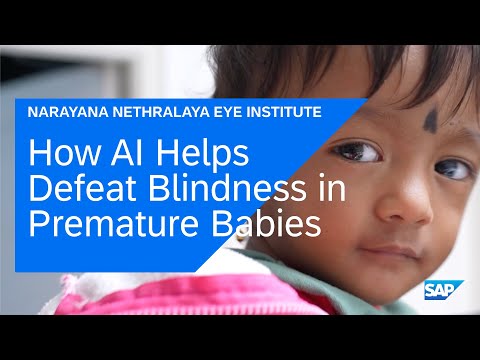In the expanses of India, where healthcare resources can be limited, the use of AI technology from SAP and CleaVision is casting a ray of hope for newborn babies vulnerable to Retinopathy of Prematurity (ROP), a condition that – if left untreated – can lead to irreversible blindness. This groundbreaking combination of medicine and technology provides a tangible solution to prevent blindness in newborns across India.
ROP is a disease that affects premature babies and impacts India significantly since the country has more than 3 million babies born premature every year, the highest number in the world. “About 25% to 40% of these babies have a risk of developing ROP,” says Dr. Anand Vinekar, head of the Department of Pediatric Retina at Narayana Nethralaya Eye Institute in Bangalore and the founder of KIDROP, a program working to address the problem of ROP in rural India.
Blindness from ROP is largely preventable if identified and treated within the first weeks of birth. But while the screening itself is not difficult for a trained provider, the challenge of detecting ROP in millions of premature babies is profound. Each preterm infant must be screened multiple times during the critical period, equating to upwards of 20 million exams per year if every preterm baby is screened, Dr. Vinekar says.
The vast distances that many families in India live from hospitals, combined with a critical shortage of specialized doctors, make this a nearly impossible task using current methods. However, KIDROP, CleaVision, and SAP are using AI to help bridge this gap and offer a lifeline to infants like Hanvith C.
Hanvith C’s parents faced the fear that haunts many new parents in India. “My father was blind,” his mother shares, voicing a worry rooted in personal history. The prospect of her newborn inheriting blindness was a terrifying thought that led the parents to seek help – a decision that would alter the course of their child’s life.
Hanvith C’s father recounts their fortunate encounter with a KIDROP team at their local hospital. Thanks to this vital outreach effort bringing sophisticated medical screening to India’s rural communities, Hanvith C was diagnosed with ROP symptoms. But with successful follow-up treatment in Bangalore, his story became one of hope rather than despair.
The KIDROP program is now working to bring these life-changing diagnostic abilities to more underserved areas by training non-physicians to use field imaging cameras to take digital images of babies’ eyes. But the resultant thousands of retinal scans that need to be reviewed for signs of ROP creates additional challenges. “Now you have plenty of images and no one to read them,” says Dr. Vinekar, explaining the bottleneck in the diagnostic and treatment process.
This is where CleaVision’s solution, supported by SAP Business AI technology – including SAP Business Technology Platform (SAP BTP) and the SAP Analytics Cloud solution – becomes a game changer. The eye images are uploaded to CleaVision, which automates the identification of retina and blood vessel features and makes a recommendation on whether ROP is present in premature babies. The system then allows doctors to quickly identify and prioritize at-risk children.
“We are not going to base our entire decision and management on what [the AI] says,” Dr. Vinekar clarifies. “But it’ll help us to triage these images.” This reflects a balanced approach towards leveraging technology while maintaining the primacy of human judgment in critical healthcare decisions.
The impact of AI from SAP and CleaVision is not just on the technological and medical fronts; it’s profoundly personal and life-changing. Hanvith C’s parents emphasize the importance of awareness and early intervention and hope other families benefit from this technology.
Their dreams for Hanvith C’s future are simple yet profound. “We want him to become a doctor, do good, and help other people when he grows up,” his mother says. “Just like they helped us at the very beginning of his life.”
About CleaVision
CleaVision is a sustainable social venture founded in 2017 by Chirag Gupta and Narayan V K as part of the SAP One Billion Lives program. The CleaVision initiative uses intelligent technologies to deliver timely diagnosis for eye diseases, such as ROP, to those without access to healthcare in developing countries.
CleaVision’s solution integrates image data processing with AI tools to automate the identification of retina and blood vessel features and to make a recommendation on whether ROP is present in premature babies. The screening data is then served to hospitals and can be reviewed by qualified medical professionals via a telemedicine network. The goal is to scale the screening program by using trained non-physicians to capture the retinal images and CleaVision technology to review the image files, saving significant time for technicians and ROP specialists.
This story was originally published on the global SAP News Center.




